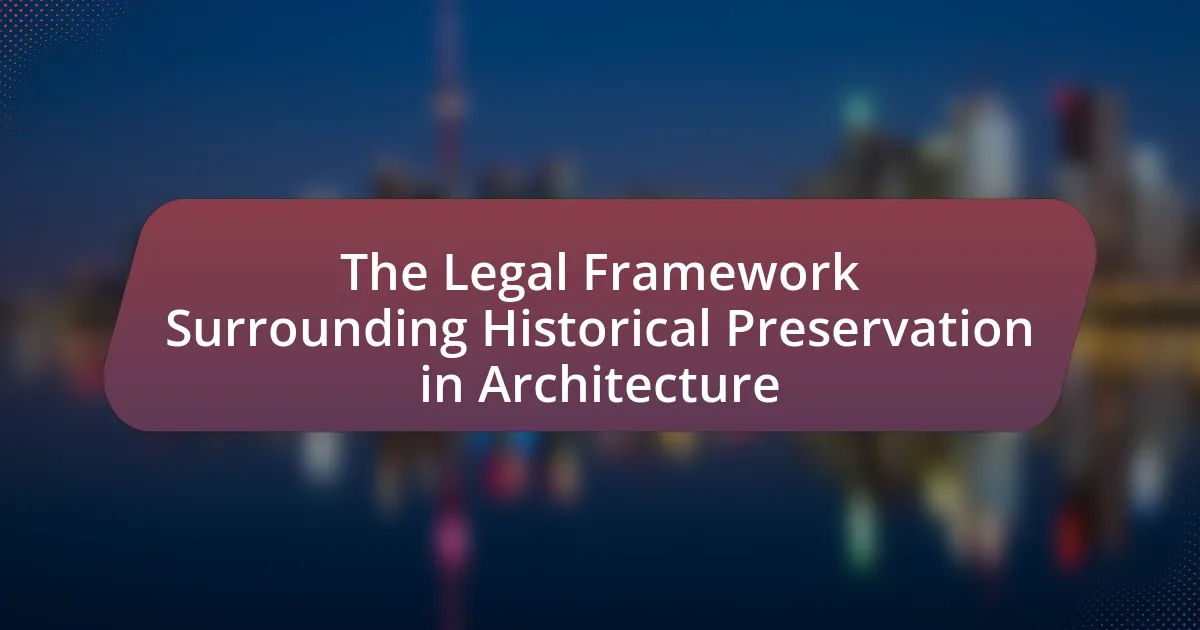Architecture studios play a vital role in historical preservation projects by leveraging their expertise in restoration and adaptive reuse of historic structures. They assess architectural integrity and historical significance, ensuring modifications adhere to preservation standards set by organizations like the National Park Service. Through collaboration with historians and preservationists, architecture studios employ specialized skills in research, documentation, and compliance to maintain the authenticity of historical sites. The article explores the processes architecture studios follow, the challenges they face, and the importance of community engagement in preserving cultural heritage while balancing modern needs.

What is the role of architecture studios in historical preservation projects?
Architecture studios play a crucial role in historical preservation projects by providing expertise in the restoration and adaptive reuse of historic structures. These studios assess the architectural integrity and historical significance of buildings, ensuring that any modifications respect the original design and materials. For instance, architecture firms often collaborate with preservationists to develop plans that comply with local and national preservation standards, such as the Secretary of the Interior’s Standards for the Treatment of Historic Properties. This collaboration helps maintain the cultural heritage and historical context of the structures while allowing for modern functionality.
How do architecture studios contribute to the preservation of historical sites?
Architecture studios contribute to the preservation of historical sites by employing specialized design techniques and restoration practices that maintain the integrity of the original structures. These studios often conduct thorough historical research to understand the architectural significance and cultural context of the sites, ensuring that any restoration work aligns with preservation standards set by organizations such as the National Park Service. For example, architecture firms frequently utilize traditional materials and craftsmanship methods that reflect the original construction, which is essential for maintaining authenticity. Additionally, they may engage in adaptive reuse strategies, allowing historical buildings to serve modern functions while preserving their historical character. This approach not only safeguards the physical structure but also enhances community engagement and appreciation for cultural heritage.
What specific skills do architecture studios bring to historical preservation?
Architecture studios bring specialized skills in research, documentation, restoration techniques, and compliance with preservation standards to historical preservation. These studios conduct thorough historical research to understand the significance of structures, ensuring that restoration efforts maintain the original architectural integrity. They utilize advanced documentation methods, such as 3D scanning and photogrammetry, to create accurate representations of existing conditions. Furthermore, architecture studios are adept in restoration techniques that respect the original materials and craftsmanship, often employing traditional methods alongside modern technology. They also navigate local, state, and federal preservation regulations, ensuring that projects comply with guidelines set by organizations like the National Park Service. This combination of skills enables architecture studios to effectively preserve historical sites while enhancing their cultural value.
How do architecture studios collaborate with historians and preservationists?
Architecture studios collaborate with historians and preservationists by engaging in interdisciplinary projects that integrate historical research with design practices. This collaboration often involves architecture studios conducting thorough assessments of historical sites, while historians provide context and significance related to the cultural heritage of those sites. Preservationists contribute guidelines and standards for maintaining the integrity of historical structures, ensuring that any architectural interventions respect the original design and materials. For instance, the National Park Service in the United States outlines specific preservation standards that architecture studios must follow when working on historical buildings, reinforcing the importance of this collaborative approach.
Why is the involvement of architecture studios crucial in historical preservation?
The involvement of architecture studios is crucial in historical preservation because they possess the expertise to balance modern needs with the integrity of historical structures. Architecture studios apply specialized knowledge in restoration techniques, materials, and historical context, ensuring that renovations respect the original design and significance of the building. For instance, the National Park Service emphasizes the importance of using historically accurate materials and methods in preservation projects, which architecture studios are trained to implement effectively. This expertise not only safeguards the architectural heritage but also enhances the cultural value of the site for future generations.
What are the potential consequences of inadequate architectural input in preservation projects?
Inadequate architectural input in preservation projects can lead to structural deterioration and loss of historical integrity. When architectural expertise is lacking, projects may fail to adhere to preservation standards, resulting in alterations that compromise the original design and materials. For instance, the National Park Service emphasizes that improper restoration techniques can lead to irreversible damage, such as the use of incompatible materials that accelerate decay. Additionally, insufficient planning can result in budget overruns and project delays, as seen in various case studies where lack of architectural guidance led to mismanagement of resources. Ultimately, these consequences not only affect the physical structure but also diminish cultural heritage value, as the historical narrative becomes obscured or lost.
How do architecture studios ensure compliance with preservation standards?
Architecture studios ensure compliance with preservation standards by conducting thorough research on historical significance and adhering to established guidelines. They utilize frameworks such as the Secretary of the Interior’s Standards for the Treatment of Historic Properties, which provide specific criteria for preservation, rehabilitation, restoration, and reconstruction. Additionally, architecture studios often collaborate with preservation specialists and local heritage organizations to align their projects with community values and legal requirements. This collaborative approach ensures that the architectural integrity and historical context of the site are maintained, thereby reinforcing compliance with preservation standards.

What processes do architecture studios follow in historical preservation projects?
Architecture studios follow a systematic process in historical preservation projects that typically includes research, documentation, assessment, design, and implementation. Initially, studios conduct thorough research to understand the historical significance and context of the building or site, often referencing historical records and previous studies. Following this, they document the existing conditions through detailed surveys and photographs, which serve as a baseline for further analysis.
Next, architecture studios assess the structural integrity and materials of the building, identifying areas that require restoration or conservation. This assessment is crucial for developing a preservation plan that aligns with established guidelines, such as the Secretary of the Interior’s Standards for the Treatment of Historic Properties.
Once the assessment is complete, studios create design proposals that respect the historical character while addressing modern needs. These proposals are often reviewed by preservation boards or local authorities to ensure compliance with regulations. Finally, the implementation phase involves executing the preservation work, which may include restoration, rehabilitation, or adaptive reuse, ensuring that all interventions are reversible and maintain the building’s historical integrity.
This structured approach ensures that architecture studios effectively balance the preservation of historical value with contemporary functionality.
How do architecture studios assess the condition of historical structures?
Architecture studios assess the condition of historical structures through a combination of visual inspections, material analysis, and structural evaluations. Initially, architects conduct thorough visual inspections to identify visible signs of deterioration, such as cracks, water damage, or pest infestations. Following this, they perform material analysis, which may include testing samples of masonry, wood, or metal to determine their integrity and composition. Additionally, structural evaluations involve assessing load-bearing elements and overall stability, often utilizing tools like laser scanning or photogrammetry for precise measurements. These methods are supported by guidelines from organizations such as the National Park Service, which provides standards for evaluating historic properties, ensuring that assessments are both systematic and comprehensive.
What tools and techniques do architecture studios use for assessment?
Architecture studios use a variety of tools and techniques for assessment, including digital modeling software, historical research methods, and site analysis techniques. Digital modeling software, such as AutoCAD and Revit, allows architects to create precise representations of existing structures, facilitating detailed assessments of their condition and historical significance. Historical research methods involve examining archival documents, photographs, and previous restoration efforts to understand the context and evolution of a building. Site analysis techniques, including physical inspections and environmental assessments, help identify structural issues and the impact of surrounding elements on the historical site. These combined approaches ensure a comprehensive evaluation of historical preservation projects, enabling informed decision-making and effective restoration strategies.
How do architecture studios prioritize preservation needs based on their assessments?
Architecture studios prioritize preservation needs by conducting thorough assessments that evaluate the historical significance, structural integrity, and cultural context of a site. These assessments involve analyzing architectural features, historical documents, and community input to determine which elements are essential for preservation. For instance, studios may prioritize structures that are listed on national registers or have significant historical value, as these factors often dictate preservation guidelines and funding opportunities. By integrating these assessments into their planning processes, architecture studios ensure that preservation efforts align with both regulatory requirements and community values, ultimately safeguarding the historical integrity of the site.
What design strategies do architecture studios employ in preservation projects?
Architecture studios employ several design strategies in preservation projects, including adaptive reuse, historical research, and material conservation. Adaptive reuse involves repurposing existing structures for new functions while maintaining their historical significance, which has been shown to enhance sustainability and community engagement. Historical research ensures that design decisions are informed by the building’s original context, style, and cultural significance, often utilizing archival materials and expert consultations. Material conservation focuses on preserving original materials and craftsmanship, which is critical for maintaining the authenticity and integrity of historical buildings. These strategies collectively contribute to the successful preservation of architectural heritage while accommodating contemporary needs.
How do architecture studios balance modern needs with historical integrity?
Architecture studios balance modern needs with historical integrity by employing adaptive reuse strategies that respect original architectural elements while integrating contemporary functionalities. These studios often conduct thorough historical research to understand the significance of existing structures, ensuring that renovations enhance rather than detract from historical value. For instance, the preservation of original materials and design features, such as moldings or facades, is common practice, allowing for a seamless blend of old and new. Additionally, many architecture firms utilize modern technologies, like Building Information Modeling (BIM), to visualize and plan renovations that maintain historical context while meeting current building codes and user requirements. This approach not only preserves cultural heritage but also promotes sustainability by reducing waste associated with new construction.
What role does community input play in the design process of preservation projects?
Community input is essential in the design process of preservation projects as it ensures that the needs and values of local stakeholders are integrated into the project. Engaging the community allows architects and planners to gather insights about historical significance, cultural relevance, and practical concerns that may not be apparent from an external perspective. For instance, studies have shown that projects incorporating community feedback often experience higher levels of public support and successful implementation, as seen in the revitalization efforts in neighborhoods like the Lower East Side in New York City, where local voices shaped the preservation of cultural landmarks. This collaborative approach not only enhances the project’s relevance but also fosters a sense of ownership and pride among community members, ultimately leading to more sustainable preservation outcomes.

What challenges do architecture studios face in historical preservation projects?
Architecture studios face several challenges in historical preservation projects, primarily including regulatory constraints, funding limitations, and the need for specialized expertise. Regulatory constraints arise from strict preservation laws and guidelines that dictate how historical structures can be modified or restored, often leading to conflicts between modern needs and preservation requirements. Funding limitations frequently hinder the ability to undertake comprehensive restoration efforts, as many projects rely on grants or donations that may not cover the full scope of work needed. Additionally, the need for specialized expertise in historical materials and construction techniques complicates the process, as architects must often collaborate with historians, conservators, and craftsmen who possess the necessary skills to ensure authenticity and compliance with preservation standards. These challenges collectively impact the feasibility and success of preservation projects undertaken by architecture studios.
How do budget constraints impact preservation efforts by architecture studios?
Budget constraints significantly limit preservation efforts by architecture studios, often resulting in reduced scope and quality of restoration projects. When financial resources are restricted, studios may prioritize essential repairs over comprehensive restorations, leading to the potential loss of historical integrity. For instance, a study by the National Trust for Historic Preservation indicates that projects with limited budgets frequently opt for less expensive materials and methods, which can compromise the authenticity of the original structure. Additionally, budget limitations can restrict the hiring of specialized craftsmen, further impacting the quality of preservation work.
What strategies can architecture studios use to manage limited budgets?
Architecture studios can manage limited budgets by prioritizing cost-effective design solutions and leveraging technology for efficiency. By focusing on adaptive reuse of existing structures, studios can minimize construction costs while preserving historical integrity. Additionally, utilizing Building Information Modeling (BIM) allows for precise planning and resource allocation, reducing waste and unforeseen expenses. Research indicates that projects employing BIM can see cost savings of up to 20% due to improved collaboration and reduced errors. Furthermore, engaging in value engineering helps identify essential project elements, ensuring that funds are allocated effectively without compromising quality.
How do architecture studios navigate regulatory challenges in preservation projects?
Architecture studios navigate regulatory challenges in preservation projects by closely collaborating with local authorities and adhering to established guidelines. They conduct thorough research on zoning laws, historical designations, and preservation standards to ensure compliance. For instance, studios often engage with the Secretary of the Interior’s Standards for the Treatment of Historic Properties, which provides a framework for maintaining the integrity of historical sites. Additionally, architecture studios may participate in public hearings and community consultations to address concerns and gather support, thereby facilitating smoother project approvals. This proactive approach not only mitigates regulatory risks but also fosters community engagement and enhances project outcomes.
What are the common misconceptions about architecture studios in historical preservation?
Common misconceptions about architecture studios in historical preservation include the belief that these studios primarily focus on restoring buildings to their original state without considering modern needs. In reality, architecture studios often balance historical integrity with contemporary functionality, ensuring that preserved sites meet current safety and accessibility standards. Another misconception is that preservation work is solely about maintaining aesthetics; however, architecture studios also engage in extensive research and documentation to understand the historical significance and context of structures. Additionally, some people think that preservation is a straightforward process, but it often involves navigating complex regulations and community interests, requiring specialized knowledge and skills.
How can architecture studios educate the public about their role in preservation?
Architecture studios can educate the public about their role in preservation by hosting community workshops and informational sessions that highlight the importance of historical architecture. These events can showcase case studies of successful preservation projects, illustrating how architecture contributes to maintaining cultural heritage. For instance, the National Trust for Historic Preservation reports that preservation efforts can enhance community identity and economic vitality, demonstrating the tangible benefits of such initiatives. By engaging with the community through interactive discussions and visual presentations, architecture studios can effectively communicate their expertise and the significance of their work in preserving historical sites.
What are the myths surrounding the capabilities of architecture studios in this field?
Architecture studios are often believed to lack the expertise necessary for effective historical preservation projects, which is a myth. In reality, many architecture studios specialize in this field, employing professionals with training in conservation techniques, historical research, and regulatory compliance. For instance, the American Institute of Architects recognizes the importance of preservation and offers resources and certifications for architects focused on this area. Additionally, successful projects, such as the restoration of the Notre-Dame Cathedral in Paris, demonstrate that architecture studios can effectively manage complex historical preservation efforts, combining modern techniques with respect for historical integrity.
What best practices should architecture studios follow in historical preservation projects?
Architecture studios should prioritize thorough research and documentation of historical significance in preservation projects. This involves understanding the architectural style, materials, and historical context of the building, which ensures that any interventions respect its original character. For instance, the Secretary of the Interior’s Standards for the Treatment of Historic Properties outlines guidelines that emphasize retaining and preserving historic materials and features. Additionally, engaging with local communities and stakeholders can provide valuable insights and foster support for preservation efforts. By adhering to these practices, architecture studios can effectively contribute to the integrity and longevity of historical sites.
How can architecture studios effectively engage with local communities during preservation projects?
Architecture studios can effectively engage with local communities during preservation projects by implementing participatory design processes that involve community members in decision-making. This approach fosters collaboration and ensures that the needs and values of the local population are reflected in the preservation efforts. For instance, studies have shown that when architecture firms conduct workshops and public meetings, they can gather valuable input that enhances project relevance and community support. Research by the National Trust for Historic Preservation indicates that community involvement leads to higher satisfaction rates and better project outcomes, as local insights often reveal historical significance and cultural context that may not be apparent to external designers.
What are the key considerations for architecture studios when planning preservation strategies?
Architecture studios must prioritize historical significance, structural integrity, and community context when planning preservation strategies. Historical significance involves understanding the cultural and architectural value of the building, ensuring that its unique characteristics are maintained. Structural integrity requires a thorough assessment of the building’s condition to identify necessary repairs while preserving original materials and techniques. Community context emphasizes the importance of engaging local stakeholders and considering the building’s role within the neighborhood, which can influence design decisions and promote public support. These considerations are essential for creating effective preservation strategies that honor the past while accommodating contemporary needs.





